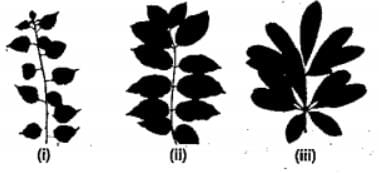All Exams >
NEET >
NCERTs at Fingertips: Textbooks, Tests & Solutions >
All Questions
All questions of Morphology of Flowering Plants for NEET Exam
Which among the following is incorrect about reticulate and parallel venation?- a)In reticulate venation, veins are arranged haphazardly
- b)In palmate venation, only one strong mid-rib is present
- c)In parallel venation, veins are arranged in a parallel manner
- d)Rice is an example of convergent palmate parallel venation
Correct answer is option 'B'. Can you explain this answer?
Which among the following is incorrect about reticulate and parallel venation?
a)
In reticulate venation, veins are arranged haphazardly
b)
In palmate venation, only one strong mid-rib is present
c)
In parallel venation, veins are arranged in a parallel manner
d)
Rice is an example of convergent palmate parallel venation

|
Imk Pathsala answered |
- In reticulate venation, veins are arranged haphazardly.
- However in parallel venation, veins are arranged in a parallel manner.
- Both the kinds can be further classified into palmate and pinnate.
- In pinnate venation, only one strong mid-rib is present and in palmate venation more than one strong rib is present.
- Rice is an example of convergent palmate parallel venation.
In _____ phyllotaxy, a pair of leaves arise at each node and lie opposite to each other as in _____ plant.- a)altemate, Hibiscus
- b)opposite, Hibiscus
- c)opposite,Calotropis
- d)whorled, Calotropis
Correct answer is option 'C'. Can you explain this answer?
In _____ phyllotaxy, a pair of leaves arise at each node and lie opposite to each other as in _____ plant.
a)
altemate, Hibiscus
b)
opposite, Hibiscus
c)
opposite,Calotropis
d)
whorled, Calotropis

|
Reema Shibily answered |
Opposite phyllotaxy
eg:- calotropis and guava
eg:- calotropis and guava
Endospermic seeds are found in
- a)barley
- b)castor
- c)Both a & b
- d)pea
Correct answer is option 'C'. Can you explain this answer?
Endospermic seeds are found in
a)
barley
b)
castor
c)
Both a & b
d)
pea
|
|
Anjali Sharma answered |
Food storing tissue of a seed is endosperm. In flowering plants it is produced as a result of double fertilization. In most monocots and some dicot seeds, the food reserve remains in the endosperm. They are called endospermic or albuminous seeds, example: cereals, castor bean, coconuts, rubber. In majority of dicot seeds (example: pea, gram, bean, mustard, groundnut) and some monocot seeds (example: orchids, Sagittaria), the endosperm is consumed during seed development and the food is stored in cotyledons and other regions. They are called non-endospermic or exalbuminous seeds.
Maize grain is a fruit known as- a)cypsela
- b)caryopsis
- c)legume
- d)achene
Correct answer is option 'B'. Can you explain this answer?
Maize grain is a fruit known as
a)
cypsela
b)
caryopsis
c)
legume
d)
achene
|
|
Dev Patel answered |
Caryopsis is a small, indehiscent, one seeded fruit developping from a monocarpellary ovary and in which the pericarp is fused with the seed coat. The seed copletely fills the chamber, e.g., wheat, maize.
निम्नलिखित कथनों पर विचार करें:1. जैविक कचरे द्वारा जल प्रदूषण को जैव रासायनिक ऑक्सीजन डिमांड (बीओडी) के संदर्भ में मापा जाता है।2. बीओडी पानी में मौजूद कार्बनिक कचरे को विघटित करने में बैक्टीरिया द्वारा आवश्यक घुलित ऑक्सीजन की मात्रा है।3. यह प्रति लीटर पानी में ऑक्सीजन के मिलीग्राम में व्यक्त किया जाता है।इनमें से कौन सा कथन सही है / सही है?- a)केवल 1 और 2
- b)केवल 2 और 3
- c)केवल 1 और 3
- d)ऊपर के सभी
Correct answer is option 'D'. Can you explain this answer?
निम्नलिखित कथनों पर विचार करें:
1. जैविक कचरे द्वारा जल प्रदूषण को जैव रासायनिक ऑक्सीजन डिमांड (बीओडी) के संदर्भ में मापा जाता है।
2. बीओडी पानी में मौजूद कार्बनिक कचरे को विघटित करने में बैक्टीरिया द्वारा आवश्यक घुलित ऑक्सीजन की मात्रा है।
3. यह प्रति लीटर पानी में ऑक्सीजन के मिलीग्राम में व्यक्त किया जाता है।
इनमें से कौन सा कथन सही है / सही है?
a)
केवल 1 और 2
b)
केवल 2 और 3
c)
केवल 1 और 3
d)
ऊपर के सभी
|
|
Deepa Iyer answered |
डीओ, बीओडी, पानी में कार्बनिक और अकार्बनिक कचरे की कॉड उपस्थिति पानी की भंग ऑक्सीजन (डीओ) सामग्री को कम कर देती है। 8.0 मिलीग्राम एल -1 से नीचे डीओ सामग्री वाले पानी को दूषित माना जा सकता है। नीचे डीओ सामग्री वाला पानी। 4.0 मिलीग्राम एल -1 को अत्यधिक प्रदूषित माना जाता है। जलीय जीवों के अस्तित्व के लिए पानी की मात्रा महत्वपूर्ण है।
Which of the following statements is/are false about the leaf?
a. The leaf develops at the node and bears a bud in its axil.
b. The leaf is the most important vegetative organ for photosynthesis.
c. Pulvinus provides rigidity to the leaf blade and acts as a channel for transporting water, minerals and food materials.- a)Only a
- b)Only a and b
- c)Only c
- d)Only b
Correct answer is option 'C'. Can you explain this answer?
Which of the following statements is/are false about the leaf?
a. The leaf develops at the node and bears a bud in its axil.
b. The leaf is the most important vegetative organ for photosynthesis.
c. Pulvinus provides rigidity to the leaf blade and acts as a channel for transporting water, minerals and food materials.
a. The leaf develops at the node and bears a bud in its axil.
b. The leaf is the most important vegetative organ for photosynthesis.
c. Pulvinus provides rigidity to the leaf blade and acts as a channel for transporting water, minerals and food materials.
a)
Only a
b)
Only a and b
c)
Only c
d)
Only b
|
|
Navya Choudhury answered |
Understanding Leaf Structure and Functions
The statements provided about leaves can be analyzed to identify the false ones. Here’s a breakdown:
Statement Analysis
- Statement a: "The leaf develops at the node and bears a bud in its axil."
- This statement is true. Leaves typically emerge from nodes on the stem, and they often have a bud in their axillary position.
- Statement b: "The leaf is the most important vegetative organ for photosynthesis."
- This statement is also true. Leaves contain chlorophyll and are primarily responsible for photosynthesis, converting sunlight into energy.
- Statement c: "Pulvinus provides rigidity to the leaf blade and acts as a channel for transporting water, minerals, and food materials."
- This statement is false. The pulvinus is a thickened area at the base of the leaf petiole that helps in leaf movement but does not provide rigidity or serve as a transport channel. Water, minerals, and food are transported through vascular tissues (xylem and phloem) located within the leaf and stem.
Conclusion
Based on the above analysis, the only false statement is statement c. Thus, the correct answer is option 'c' - "Only c". Understanding these aspects of leaf structure helps in comprehending their vital roles in plant physiology, especially in photosynthesis and overall plant health.
The statements provided about leaves can be analyzed to identify the false ones. Here’s a breakdown:
Statement Analysis
- Statement a: "The leaf develops at the node and bears a bud in its axil."
- This statement is true. Leaves typically emerge from nodes on the stem, and they often have a bud in their axillary position.
- Statement b: "The leaf is the most important vegetative organ for photosynthesis."
- This statement is also true. Leaves contain chlorophyll and are primarily responsible for photosynthesis, converting sunlight into energy.
- Statement c: "Pulvinus provides rigidity to the leaf blade and acts as a channel for transporting water, minerals, and food materials."
- This statement is false. The pulvinus is a thickened area at the base of the leaf petiole that helps in leaf movement but does not provide rigidity or serve as a transport channel. Water, minerals, and food are transported through vascular tissues (xylem and phloem) located within the leaf and stem.
Conclusion
Based on the above analysis, the only false statement is statement c. Thus, the correct answer is option 'c' - "Only c". Understanding these aspects of leaf structure helps in comprehending their vital roles in plant physiology, especially in photosynthesis and overall plant health.
What is the function of the root cap?- a)It absorbs water and minerals from the soil.
- b)It protects the tender apex of the root as it grows through the soil.
- c)It helps in storing food material.
- d)It aids in the elongation of the root.
Correct answer is option 'B'. Can you explain this answer?
a)
It absorbs water and minerals from the soil.
b)
It protects the tender apex of the root as it grows through the soil.
c)
It helps in storing food material.
d)
It aids in the elongation of the root.

|
Stepway Academy answered |
The root cap protects the tender apex of the root as it makes its way through the soil, ensuring that the root grows without damage.
The given figure represents vexillary aestivation. Select the suitable labels for P, Q and R .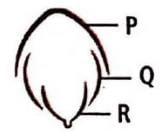
- a)Standard, Wing, Ala
- b)Standard, Carina, Ala
- c)Wing, Keel, Carina
- d)Standard, Keel, Wing
Correct answer is option 'D'. Can you explain this answer?
The given figure represents vexillary aestivation. Select the suitable labels for P, Q and R .

a)
Standard, Wing, Ala
b)
Standard, Carina, Ala
c)
Wing, Keel, Carina
d)
Standard, Keel, Wing

|
Athulya Raj answered |
In vexillary/descending imbricate aestivation,
the posterior petal (standard)-P from figure
overlaps the two lateral petals (wings or alae)-Q
and the latter overlap the two anterior petals (keel or carina) - S .
It is also called papilionaceous corolla and is found in members of Family Papilionaceae.
the posterior petal (standard)-P from figure
overlaps the two lateral petals (wings or alae)-Q
and the latter overlap the two anterior petals (keel or carina) - S .
It is also called papilionaceous corolla and is found in members of Family Papilionaceae.
In which type of plants is the fibrous root system commonly found?- a)Monocotyledonous plants
- b)Dicotyledonous plants
- c)Both monocotyledonous and dicotyledonous plants
- d)Plants with adventitious roots
Correct answer is option 'A'. Can you explain this answer?
a)
Monocotyledonous plants
b)
Dicotyledonous plants
c)
Both monocotyledonous and dicotyledonous plants
d)
Plants with adventitious roots
|
|
Shruti Rane answered |
Understanding Root Systems
In the plant kingdom, root systems play a crucial role in anchoring the plant and absorbing nutrients and water. The two primary types of root systems are fibrous and taproot systems.
Fibrous Root System in Monocots
The fibrous root system is typically found in monocotyledonous plants (monocots). Here’s a deeper look into why this is the case:
Conclusion
In summary, the fibrous root system is characteristic of monocotyledonous plants. Its structure, adaptability, and stability provide significant advantages, particularly in environments where water availability is critical. Understanding this relationship enhances our knowledge of plant biology and ecology, which is essential for fields such as agriculture and conservation.
In the plant kingdom, root systems play a crucial role in anchoring the plant and absorbing nutrients and water. The two primary types of root systems are fibrous and taproot systems.
Fibrous Root System in Monocots
The fibrous root system is typically found in monocotyledonous plants (monocots). Here’s a deeper look into why this is the case:
- Structure: Monocots, like grasses and lilies, develop a network of thin, fibrous roots that spread horizontally. This contrasts with dicots, which often have a single, dominant taproot.
- Adaptation: The fibrous root system allows monocots to effectively absorb water and nutrients from the upper soil layers. This is particularly beneficial in environments where water may be scarce.
- Stability: The dense network of roots helps stabilize the plant, preventing erosion in the soil. This is vital for plants that grow in diverse and sometimes harsh environments.
- Examples: Common examples of monocots with fibrous root systems include wheat, rice, and corn. These plants thrive due to their efficient root architecture.
Conclusion
In summary, the fibrous root system is characteristic of monocotyledonous plants. Its structure, adaptability, and stability provide significant advantages, particularly in environments where water availability is critical. Understanding this relationship enhances our knowledge of plant biology and ecology, which is essential for fields such as agriculture and conservation.
In a longitudinal section of a root, starting from the tip upward, the four zones occur in the following order:- a)Root cap, cell division, cell maturation, cell enlargement
- b)Cell division, cell enlargement, cell maturation, root cap
- c)Cell division, cell maturation, cell enlargement, root cap
- d)Root cap, cell division, cell enlargement, cell maturation
Correct answer is option 'D'. Can you explain this answer?
In a longitudinal section of a root, starting from the tip upward, the four zones occur in the following order:
a)
Root cap, cell division, cell maturation, cell enlargement
b)
Cell division, cell enlargement, cell maturation, root cap
c)
Cell division, cell maturation, cell enlargement, root cap
d)
Root cap, cell division, cell enlargement, cell maturation

|
Lead Academy answered |
In a longitudinal section of the root, the zones occur in the following order:
Root cap
Region of cell division (meristematic activity)
Region of cell enlargement (elongation)
Region of cell maturation (differentiation)
Root cap
Region of cell division (meristematic activity)
Region of cell enlargement (elongation)
Region of cell maturation (differentiation)
Find out the incorrect match.- a)Sterile stamen - Staminode
- b)Stamens attached to petals - Epipetalous
- c)Stamens attached to perianth - Episepalous
- d)Free stamens - Polyandrous
Correct answer is option 'C'. Can you explain this answer?
Find out the incorrect match.
a)
Sterile stamen - Staminode
b)
Stamens attached to petals - Epipetalous
c)
Stamens attached to perianth - Episepalous
d)
Free stamens - Polyandrous
|
|
Riya Banerjee answered |
When stamens are attached to the perianth, they are known as epiphyllous, e.g., Asparagus, lily.
Which of the following statements correctly describes the structure of a seed?- a)The hilum is the scar on the seed coat through which the embryo attaches to the fruit.
- b)The micropyle is located below the hilum and is not involved in seed development.
- c)The cotyledons are the outer layers of the seed coat, providing protection to the embryo.
- d)The seed coat consists of two layers: the outer testa and the inner tegmen.
Correct answer is option 'D'. Can you explain this answer?
a)
The hilum is the scar on the seed coat through which the embryo attaches to the fruit.
b)
The micropyle is located below the hilum and is not involved in seed development.
c)
The cotyledons are the outer layers of the seed coat, providing protection to the embryo.
d)
The seed coat consists of two layers: the outer testa and the inner tegmen.
|
|
Aashna Rane answered |
Understanding Seed Structure
The correct answer is option 'D', which accurately describes the structure of a seed. Here’s a detailed breakdown of the components:
Seed Coat Layers
- The seed coat is a protective layer that surrounds the seed, crucial for ensuring the embryo's safety during development.
- It consists of two main layers:
- Testa: The outer layer, usually hard and provides mechanical protection.
- Tegmen: The inner layer, often softer and more permeable, aiding in nutrient absorption and gas exchange.
Role of the Hilum and Micropyle
- Hilum:
- It is the scar on the seed coat where the seed was attached to the fruit. This attachment point is critical for nutrient transfer during development.
- Micropyle:
- Located above the hilum, it is an opening that facilitates water absorption during germination. It plays a significant role in seed development.
Cotyledons Function
- Cotyledons are not part of the seed coat; rather, they are the first leaves that develop from the embryo. They provide essential nutrients to the developing plant.
Conclusion
In summary, option 'D' is correct because it highlights the accurate structure of the seed coat, emphasizing the distinction between the outer testa and inner tegmen. Understanding these components is vital for comprehending plant biology, especially in the context of seed germination and development.
The correct answer is option 'D', which accurately describes the structure of a seed. Here’s a detailed breakdown of the components:
Seed Coat Layers
- The seed coat is a protective layer that surrounds the seed, crucial for ensuring the embryo's safety during development.
- It consists of two main layers:
- Testa: The outer layer, usually hard and provides mechanical protection.
- Tegmen: The inner layer, often softer and more permeable, aiding in nutrient absorption and gas exchange.
Role of the Hilum and Micropyle
- Hilum:
- It is the scar on the seed coat where the seed was attached to the fruit. This attachment point is critical for nutrient transfer during development.
- Micropyle:
- Located above the hilum, it is an opening that facilitates water absorption during germination. It plays a significant role in seed development.
Cotyledons Function
- Cotyledons are not part of the seed coat; rather, they are the first leaves that develop from the embryo. They provide essential nutrients to the developing plant.
Conclusion
In summary, option 'D' is correct because it highlights the accurate structure of the seed coat, emphasizing the distinction between the outer testa and inner tegmen. Understanding these components is vital for comprehending plant biology, especially in the context of seed germination and development.
If the gynoecium is present in the top most position of the thalamus, the flower is referred to as- a)hypogynous
- b)perigynous
- c)epigynous
- d)none of these
Correct answer is option 'A'. Can you explain this answer?
If the gynoecium is present in the top most position of the thalamus, the flower is referred to as
a)
hypogynous
b)
perigynous
c)
epigynous
d)
none of these
|
|
Suresh Iyer answered |
In hypogynous condition of flowers, the thalamus is convex or conical. Gynoecium occupies the topmost (superior) position at the thalamus and other parts of flower are borne successively below. Androperianth or other floral organs are inferior, e.g, Hibiscus rosa sinensis, Ranunculus, etc.
Select the incorrect statement out of the following.- a)Assimilatory roots capable of photosynthesis at present in Tinospora and Trapa.
- b)Haustoria of Cuscuta make connection with box xylem and phoem tissues of host.
- c)Reproductive roots of lpomoea batata help in vegetion propagation.
- d)Epiphytic roots of Vanda possess well developed in caps and root hair.
Correct answer is option 'D'. Can you explain this answer?
Select the incorrect statement out of the following.
a)
Assimilatory roots capable of photosynthesis at present in Tinospora and Trapa.
b)
Haustoria of Cuscuta make connection with box xylem and phoem tissues of host.
c)
Reproductive roots of lpomoea batata help in vegetion propagation.
d)
Epiphytic roots of Vanda possess well developed in caps and root hair.
|
|
Ajay Yadav answered |
Aerial or epiphytic roots hang down in air, they do not possess root caps and root hair instead they possess a covering of dead spongy tissue called velamen.
Match Column-I with Column-ll and select the correct option from the codes given below.
Column-I (Type of fleshy taproot)
A. Conical
B. Fusiform
C. Napiform
D. Tuberous
Column-II (Example)
(i) Brassica rapa
(ii) Daucus carota
(iii) Raphanus sativus
(iv) Mirabilis jalapa- a)A-(ii), B-(iii), C-(i), D-(iv)
- b)A-(iii), B-(ii), C-(i), D-(iv)
- c)A-(ii), B-(i), C-(iii), D-(iv)
- d)A-(ii), B-(iii), C-(iv), D-(i)
Correct answer is option 'A'. Can you explain this answer?
Match Column-I with Column-ll and select the correct option from the codes given below.
Column-I (Type of fleshy taproot)
A. Conical
B. Fusiform
C. Napiform
D. Tuberous
Column-II (Example)
(i) Brassica rapa
(ii) Daucus carota
(iii) Raphanus sativus
(iv) Mirabilis jalapa
Column-I (Type of fleshy taproot)
A. Conical
B. Fusiform
C. Napiform
D. Tuberous
Column-II (Example)
(i) Brassica rapa
(ii) Daucus carota
(iii) Raphanus sativus
(iv) Mirabilis jalapa
a)
A-(ii), B-(iii), C-(i), D-(iv)
b)
A-(iii), B-(ii), C-(i), D-(iv)
c)
A-(ii), B-(i), C-(iii), D-(iv)
d)
A-(ii), B-(iii), C-(iv), D-(i)
|
|
Ajay Yadav answered |
Taproot becomes swollen and fleshy with the stored food. Depending upon the shape these fleshy taproots are of four types:
- Conical: It resembles like a cone i.e., thickest towards the base and gradually tapering apex. E.g. Daucus carota.
- Fusiform: It is like a spindle i.e., thickened roughly in the middle and narrow towards both its base and apex, e.g. Raphanus sativus.
- Napiform: It is very thick at the base and is almost spherical. It suddenly thins out towards the apex, e.g. Brassica rapa.
- Tuberous: They are thick and fleshy tubers with an irregular shape, e.g. Mirabilis jalapa.
So, the correct answer is A-(ii), B-(iii), C-(i), D-(iv).
In _____ aestivation, sepals or petals in a whorl just touch one another at the margins, without overlapping, as is found in _____ .
- a)valvate, Calotropis
- b)Valvate, Hibiscus
- c)twisted, Calotropis
- d)twisted, Hibiscus
Correct answer is option 'A'. Can you explain this answer?
In _____ aestivation, sepals or petals in a whorl just touch one another at the margins, without overlapping, as is found in _____ .
a)
valvate, Calotropis
b)
Valvate, Hibiscus
c)
twisted, Calotropis
d)
twisted, Hibiscus
|
|
Ajay Yadav answered |
In valvate aestivation, sepals or petals in a whorl just touch one another at the margins without overlapping. This type of aestivation can be observed in the flowers of Calotropis.
- Valvate Aestivation: Sepals or petals in a whorl touch at the edges but do not overlap.
- Example: Calotropis exhibits valvate aestivation.
Thus, the correct answer is:
A: valvate, Calotropis
In some _____, the leaf base may become swoolen and is called as _____.- a)monocots, sheathing leaf base
- b)legumes, pulvinus
- c)legumes, sheathing leaf base
- d)monocots, pulvinus
Correct answer is option 'B'. Can you explain this answer?
In some _____, the leaf base may become swoolen and is called as _____.
a)
monocots, sheathing leaf base
b)
legumes, pulvinus
c)
legumes, sheathing leaf base
d)
monocots, pulvinus
|
|
Gaurav Kumar answered |
In many legumes leaf base is swollen, it is known as pulvinus. It is responsible for sleep and shock movements of certain leaves, e.g., Mimosa pudica.
On the basis of relative position of different floral parts on the thalamus, a flower can be hypogynous, Perigynous or epigynous. With respect to the given figures (A, B, C and D), select the correct option:
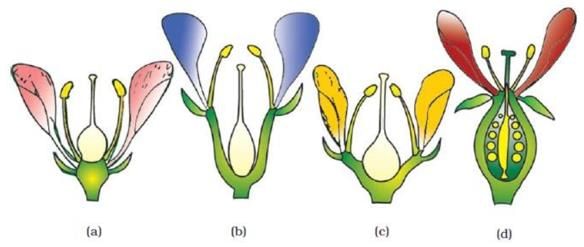
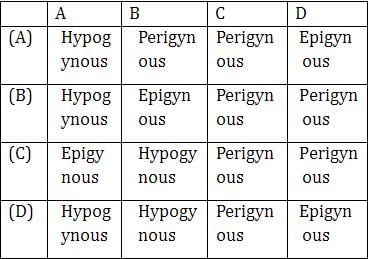
- a)a
- b)b
- c)c
- d)d
Correct answer is option 'A'. Can you explain this answer?
On the basis of relative position of different floral parts on the thalamus, a flower can be hypogynous, Perigynous or epigynous. With respect to the given figures (A, B, C and D), select the correct option:



a)
a
b)
b
c)
c
d)
d
|
|
Anjali Sharma answered |
There are three forms of thalamus in regard to the insertion of pistil and androperianth or other floral organs..
(i) Hpogyny - When the sepals, petals and stamens are successively and separately inserted below the ovary in the flowers, the condition is known to be hypogyny and the ovary is said to be ruperious. Such flowers are called hypogyous as in mustard,china rose and brinjal.
(ii) Epigyny - When the sepals, petals and stamens are successively and separately inserted above the ovary in the flower, the condition is descried as epigymy. The ovary in this situation is said to be inferior. Such flowers are termed epigynous, e.g., guave, cucumber.
(iii) perigymy - When the sepals, petals and stamens are inserted at the same plane as the ovary, the condition is known as perigyny. The ovary in such condition is half superior, sub-inferior or partially inderior ovary. Such flowers are called perigynous, e.g., rose, pea.
(i) Hpogyny - When the sepals, petals and stamens are successively and separately inserted below the ovary in the flowers, the condition is known to be hypogyny and the ovary is said to be ruperious. Such flowers are called hypogyous as in mustard,china rose and brinjal.
(ii) Epigyny - When the sepals, petals and stamens are successively and separately inserted above the ovary in the flower, the condition is descried as epigymy. The ovary in this situation is said to be inferior. Such flowers are termed epigynous, e.g., guave, cucumber.
(iii) perigymy - When the sepals, petals and stamens are inserted at the same plane as the ovary, the condition is known as perigyny. The ovary in such condition is half superior, sub-inferior or partially inderior ovary. Such flowers are called perigynous, e.g., rose, pea.
Select the correct option for A, B and C in the given diagram of papilionaceous corolla.
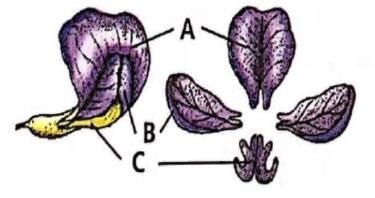
- a)Keel, Wings, Vexillum
- b)Vexillum, keel, Wings
- c)Vexillum, Wings, Keel
- d)Wings, Keel, Vexillum
Correct answer is option 'C'. Can you explain this answer?
Select the correct option for A, B and C in the given diagram of papilionaceous corolla.


a)
Keel, Wings, Vexillum
b)
Vexillum, keel, Wings
c)
Vexillum, Wings, Keel
d)
Wings, Keel, Vexillum
|
|
Suresh Iyer answered |
In papilionaceous corolla , five unequal petals are arranged like a butterfly. The posterior large bilobed petal is called standard or vexillum and it overlaps two smaller lateral petals called wings/alae. The latter in turn overlap the two anterior petals which are fused by the upper anterior margins to form a boat-shaped structure called keel or carina.
Identify A, B, C and D in the given figure showing L.S. of a monocot seed and select the correct option.
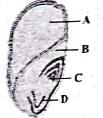
- a)Endosperm, Scutellum, Plumule, Radicle
- b)Endosperm, Scutellum, Radicle, Plumule
- c)Scutellum, Endosperm, Radicle, Plumule
- d)Plumule, Radicle, Scutellum, Endosperm
Correct answer is option 'A'. Can you explain this answer?
Identify A, B, C and D in the given figure showing L.S. of a monocot seed and select the correct option.


a)
Endosperm, Scutellum, Plumule, Radicle
b)
Endosperm, Scutellum, Radicle, Plumule
c)
Scutellum, Endosperm, Radicle, Plumule
d)
Plumule, Radicle, Scutellum, Endosperm
|
|
Ajay Yadav answered |
Monocotyledonous seeds are with a single cotyledon. The fruit wall (pericarp) and the seed coat (testa) are inseparably fused. Below the grain covering are present two structures, endosperm and embryo. The embryo in the pointed part of the grain, mostly towards the upper side. It consists of an embryo axis containing a radicle plumule and a single lateral cotyledon. The radicle for sheaths, inner root cap and outer coleorhiza. The (or future shoot) goes towards the reader side of the given at the other end of embryo axis. It bears a few rudimentary leaves and a conical protective sheath called coleoptile. The single cotyledon of monocotyledonous seed is called scutellum. It occupies the major embryo regions of grain. The endosperm occupies of the interior of the grain on the broader sides.
Based on the position of floral parts on thalamus, the flowers, are described as hypogynous, perigynous and perigynous and epigynous. Which of the following floral forms (A-D) represent the flowers of Rosa and Prunus respectively?
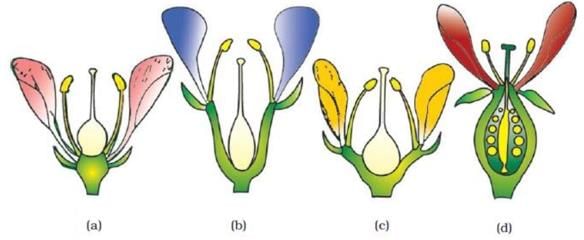
- a)A and B
- b)B and C
- c)C and D
- d)B and D
Correct answer is option 'B'. Can you explain this answer?
Based on the position of floral parts on thalamus, the flowers, are described as hypogynous, perigynous and perigynous and epigynous. Which of the following floral forms (A-D) represent the flowers of Rosa and Prunus respectively?


a)
A and B
b)
B and C
c)
C and D
d)
B and D
|
|
Preeti Iyer answered |
In perigynous condition of a filower, the gynoecium is situated in the centre and other floral parts are located on the rim of the thalamus almost at the same level. Ovary is said to be half-inferior, e g. Rosa (Flask-shaped thalamus) Prunus (Cup-shaped thalamus).
Monocotyledonous seeds possess a single cotyledon which is represented by- a)tegmen
- b)endosperm
- c)scutellum
- d)aleurone
Correct answer is option 'C'. Can you explain this answer?
Monocotyledonous seeds possess a single cotyledon which is represented by
a)
tegmen
b)
endosperm
c)
scutellum
d)
aleurone
|
|
Jyoti Sengupta answered |
The single cotyledon of monocotyledonous seed (e.g., maize grain) is called scutellum. It occupies the major portion of the embryo regions of grains.

Select the incorrect statement regarding the given figure.- a)It represents the baccate fruit of Lycopersicm esculentum.
- b)It is derived from a monocarpellary apocarpoic gyncecium.
- c)It represents the true berry of tomato.
- d)Both (b) and (c).
Correct answer is option 'B'. Can you explain this answer?

Select the incorrect statement regarding the given figure.
a)
It represents the baccate fruit of Lycopersicm esculentum.
b)
It is derived from a monocarpellary apocarpoic gyncecium.
c)
It represents the true berry of tomato.
d)
Both (b) and (c).
|
|
Jyoti Sengupta answered |
Given figure represents true berry or baccate fruit of Lycopersicum esculentum (tomato).
Which region of the root is responsible for the growth in length?- a)Region of maturation
- b)Region of meristematic activity
- c)Region of elongation
- d)Region of differentiation
Correct answer is option 'C'. Can you explain this answer?
a)
Region of maturation
b)
Region of meristematic activity
c)
Region of elongation
d)
Region of differentiation

|
EduRev NEET answered |
The region of elongation is responsible for the growth of the root in length, as cells in this region undergo rapid enlargement and elongation.
What is the primary function of the root system in plants?- a)Reproduction
- b)Absorption of water and minerals
- c)Production of flowers and seeds
- d)Photosynthesis
Correct answer is option 'B'. Can you explain this answer?
a)
Reproduction
b)
Absorption of water and minerals
c)
Production of flowers and seeds
d)
Photosynthesis

|
Top Rankers answered |
The root system primarily functions to absorb water and minerals from the soil, anchor the plant parts, store reserve food materials, and synthesize plant growth regulators.
Identify the different types of placentations shown in figure and select the correct option.

- a)Axile, Marginal, Free central, Parietal, Basal
- b)Marginal, Basal, Axile, Free central, Parietal
- c)Marginal, Axile, Parietal, Free central, Basal
- d)Marginal, Parietal, Axile, Basal, Free central
Correct answer is option 'B'. Can you explain this answer?
Identify the different types of placentations shown in figure and select the correct option.


a)
Axile, Marginal, Free central, Parietal, Basal
b)
Marginal, Basal, Axile, Free central, Parietal
c)
Marginal, Axile, Parietal, Free central, Basal
d)
Marginal, Parietal, Axile, Basal, Free central
|
|
Raghav Bansal answered |
The arrangement of ovules within the ovary is known as placentation. The placentation are of different type namely, marginal, axile, parietal, basal, central and free central. In marginal placemation the placenta forms a ridge along the ventral suture of the ovary and the ovules are borne on this ridge forming two rows, e.g. pea. When the placenta is axial and the ovules are attached to it in a multilocular ovary, the placentation is saidd to be axile, e.g., China rose, tomato and lemon In parietal placentation, the ovules develop on the inner wall of the ovary or on peripheral part. Ovary is one -chambered but it becomes two chambered due to the formation of false septum, e.g., mustard. When the ovules are borne on central axis and septa are absent, as in Primrose, the placentation is called free central In basal placentation, the placenta develops at the base of obary and a single ovule is attached to it, e.g., sunflower, marigold.
Given figure represents a drupe of mango. Select the option that correctly identifies A, B, C and D.
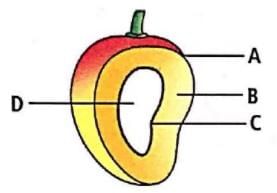
- a)Pericarp, Epicarp, Mesocarp, Endocarp
- b)Epicarp, Mesocarp, Endocarp, Seed
- c)Mesocarp, Epicarp, Endocarp, Seed
- d)Epicarp, Mesocarp, Seed, Endocarp
Correct answer is option 'B'. Can you explain this answer?
Given figure represents a drupe of mango. Select the option that correctly identifies A, B, C and D.


a)
Pericarp, Epicarp, Mesocarp, Endocarp
b)
Epicarp, Mesocarp, Endocarp, Seed
c)
Mesocarp, Epicarp, Endocarp, Seed
d)
Epicarp, Mesocarp, Seed, Endocarp
|
|
Ajay Yadav answered |
In drupes or stone fruits, the fruit wall or pericarp is differentiated into three layers - epicarp, mesocarp and endocarp. The endocarp is stony. It encloses one or rarely more seeds. In drupes derived from superior ovaries, the epicarp forms the outer skin. It may (e.e., peach, plum, cherry) or may not (e.g., mango) be edible.
Which part of the plant is responsible for the formation of the stem during germination?- a)Radicle
- b)Cotyledon
- c)Plumule
- d)Hypocotyl
Correct answer is option 'C'. Can you explain this answer?
a)
Radicle
b)
Cotyledon
c)
Plumule
d)
Hypocotyl

|
Infinity Academy answered |
The stem develops from the plumule of the embryo of a germinating seed, which is the part that grows upward to form the stem.
Which of the following figures represent a typical placentation as seen in Hibiscus rosa sinensis (China rose)?
- a)

- b)
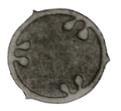
- c)

- d)

Correct answer is option 'A'. Can you explain this answer?
Which of the following figures represent a typical placentation as seen in Hibiscus rosa sinensis (China rose)?
a)

b)

c)

d)

|
|
Preeti Iyer answered |
Option (a) represents placentation as seen in China rose. It is axile type of placentation, which occurs in syncarpous pistils. Ovary is partitioned into 2 or more chambers. Placentae occur in the central region where the septa meet so that an axile column bearing ovules is formed. In China rose, ovary is pentalocular.
The given figure (A, B, and C) shows different types of roots. Identify the root which is seen in wheat plant and originate from the base of the stem?
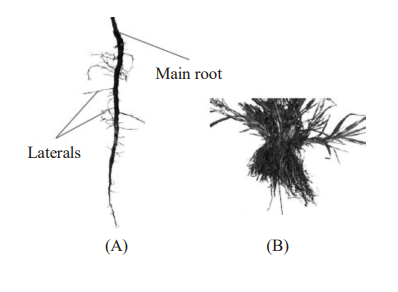

- a)(A)
- b)(B)
- c)(C)
- d)Both (A) and (B)
Correct answer is option 'B'. Can you explain this answer?
The given figure (A, B, and C) shows different types of roots. Identify the root which is seen in wheat plant and originate from the base of the stem?


a)
(A)
b)
(B)
c)
(C)
d)
Both (A) and (B)

|
Stepway Academy answered |
Line from NCERT : In monocotyledonous plants, the primary root is short lived and is replaced by a large number of roots. These roots originate from the base of the stem and constitute the fibrous root system, as seen in the wheat plant
Match the following

- a)1-D, 2-B, 3-C, 4-A
- b)1-B, 2-D, 3-A, 4-C
- c)1-D, 2-A, 3-C, 4-B
- d)1-A, 2-B, 3-D, 4-C
Correct answer is option 'A'. Can you explain this answer?
Match the following


a)
1-D, 2-B, 3-C, 4-A
b)
1-B, 2-D, 3-A, 4-C
c)
1-D, 2-A, 3-C, 4-B
d)
1-A, 2-B, 3-D, 4-C

|
Stepway Academy answered |
Node – D. Site of leaf attachment
Internode – B. Supports leaves, flowers, and fruits
Woody stem – C. Storage of food
Young green stem – A. Conducts water and minerals
Internode – B. Supports leaves, flowers, and fruits
Woody stem – C. Storage of food
Young green stem – A. Conducts water and minerals
Coleorhiza and coleoptile are the protective sheaths covening _____ and _____ respectively.- a)radicle, plumule
- b)plumule, radicle
- c)plumule, hypocotyl
- d)epicotyl, radicle
Correct answer is option 'A'. Can you explain this answer?
Coleorhiza and coleoptile are the protective sheaths covening _____ and _____ respectively.
a)
radicle, plumule
b)
plumule, radicle
c)
plumule, hypocotyl
d)
epicotyl, radicle
|
|
Anjali Sharma answered |
The embryonal axis is differentiated into radicle and plumule. In monocot seeds, the radicle is protected by a sheath called coleorhiza and the plumule is protected by coleoptile whereas in dicot seeds, the radicle and plumule are not protected by such sheaths.
Select the mismatched pair out of the following.- a)Syconus - Ficus carica
- b)Sorosis - Ananas camosus
- c)Pome - Mangifera indica
- d)Cremocarp - Coriandrum sativum
Correct answer is option 'C'. Can you explain this answer?
Select the mismatched pair out of the following.
a)
Syconus - Ficus carica
b)
Sorosis - Ananas camosus
c)
Pome - Mangifera indica
d)
Cremocarp - Coriandrum sativum
|
|
Mira Joshi answered |
Pome is a false or accessory simple succulent fruit that develops from an inferior compound ovary, e.g., apple, pear. Mango (Mangifera indica) is a drupe fruit.
Which of the following statements correctly describes the structure of a drupe?- a)The mesocarp in a mango drupe is fibrous and hard.
- b)A drupe develops from a monocarpellary superior ovary and contains multiple seeds.
- c)In a drupe, the pericarp is differentiated into epicarp, mesocarp, and endocarp.
- d)Parthenocarpic fruits result from the fertilisation of the ovary.
Correct answer is option 'C'. Can you explain this answer?
a)
The mesocarp in a mango drupe is fibrous and hard.
b)
A drupe develops from a monocarpellary superior ovary and contains multiple seeds.
c)
In a drupe, the pericarp is differentiated into epicarp, mesocarp, and endocarp.
d)
Parthenocarpic fruits result from the fertilisation of the ovary.

|
Ambition Institute answered |
A drupe, like mango and coconut, develops from a monocarpellary superior ovary and is typically one-seeded. The pericarp of a drupe is differentiated into three layers: epicarp (outer), mesocarp (fleshy), and endocarp (hard or stony). Parthenocarpic fruits, on the other hand, are formed without fertilisation.
In the context of the corolla, which of the following shapes is NOT typically associated with the structure of the petals?- a)Tubular
- b)Bell-shaped
- c)Funnel-shaped
- d)Polygonal
Correct answer is option 'D'. Can you explain this answer?
a)
Tubular
b)
Bell-shaped
c)
Funnel-shaped
d)
Polygonal

|
Ciel Knowledge answered |
The typical shapes of the corolla petals include tubular, bell-shaped, and funnel-shaped, but polygonal is not a typical shape for petals.
Which of the following is characteristic of the tap root system?- a)It has roots that arise from the base of the stem.
- b)It consists of the primary root and its lateral branches.
- c)The primary root is short-lived and replaced by numerous roots.
- d)The roots are adventitious and develop from various plant parts.
Correct answer is option 'B'. Can you explain this answer?
a)
It has roots that arise from the base of the stem.
b)
It consists of the primary root and its lateral branches.
c)
The primary root is short-lived and replaced by numerous roots.
d)
The roots are adventitious and develop from various plant parts.

|
Ciel Knowledge answered |
The tap root system is characterized by the presence of a primary root that grows inside the soil and bears lateral roots of various orders. The primary root and its branches form the tap root system, as seen in dicotyledonous plants like mustard.
Which of the following is a distinguishing feature of a stem compared to a root?- a)Presence of root hairs
- b)Absence of nodes and internodes
- c)Presence of nodes and internodes
- d)Anchorage to the soil
Correct answer is option 'C'. Can you explain this answer?
a)
Presence of root hairs
b)
Absence of nodes and internodes
c)
Presence of nodes and internodes
d)
Anchorage to the soil

|
Ambition Institute answered |
The stem is distinguished from the root by the presence of nodes (where leaves are born) and internodes (the portions between two nodes), which are not found in roots.
Chapter doubts & questions for Morphology of Flowering Plants - NCERTs at Fingertips: Textbooks, Tests & Solutions 2025 is part of NEET exam preparation. The chapters have been prepared according to the NEET exam syllabus. The Chapter doubts & questions, notes, tests & MCQs are made for NEET 2025 Exam. Find important definitions, questions, notes, meanings, examples, exercises, MCQs and online tests here.
Chapter doubts & questions of Morphology of Flowering Plants - NCERTs at Fingertips: Textbooks, Tests & Solutions in English & Hindi are available as part of NEET exam.
Download more important topics, notes, lectures and mock test series for NEET Exam by signing up for free.

Contact Support
Our team is online on weekdays between 10 AM - 7 PM
Typical reply within 3 hours
|
Free Exam Preparation
at your Fingertips!
Access Free Study Material - Test Series, Structured Courses, Free Videos & Study Notes and Prepare for Your Exam With Ease

 Join the 10M+ students on EduRev
Join the 10M+ students on EduRev
|

|
Create your account for free
OR
Forgot Password
OR
Signup to see your scores
go up within 7 days!
Access 1000+ FREE Docs, Videos and Tests
Takes less than 10 seconds to signup

